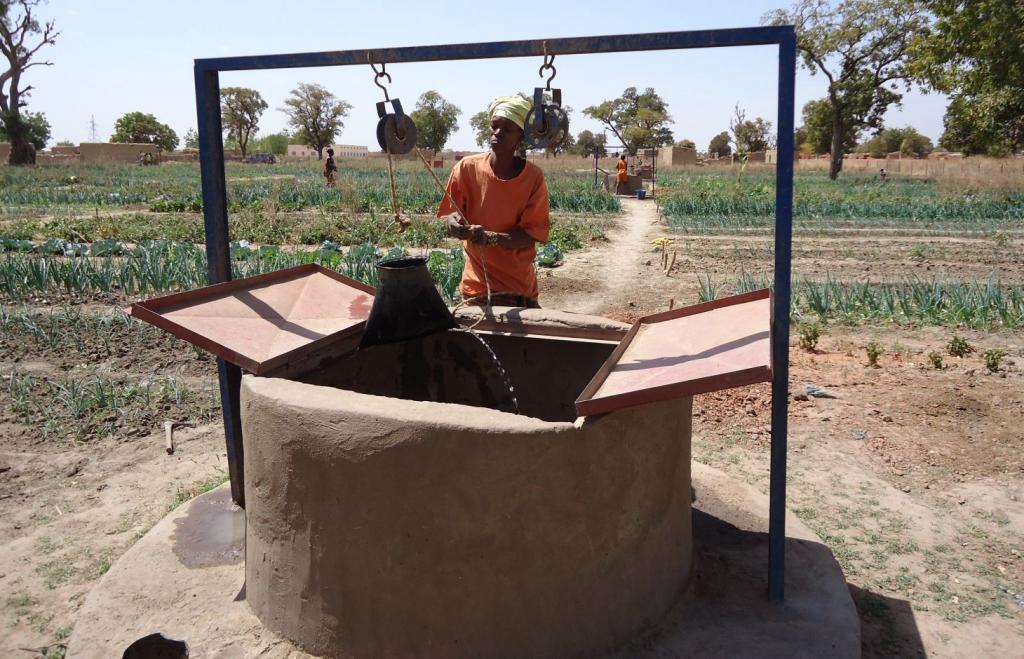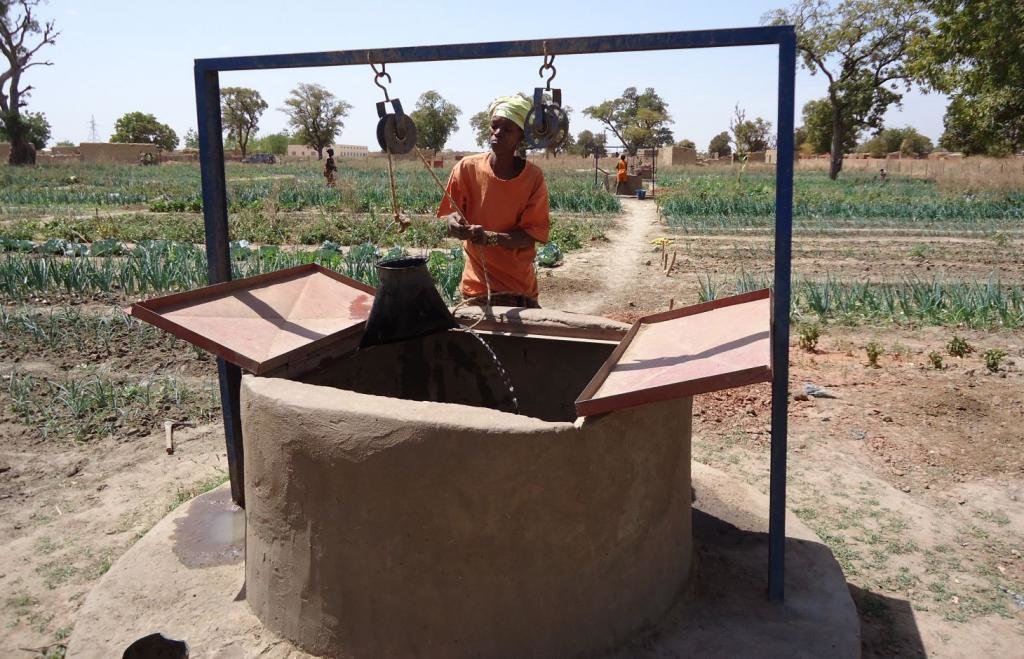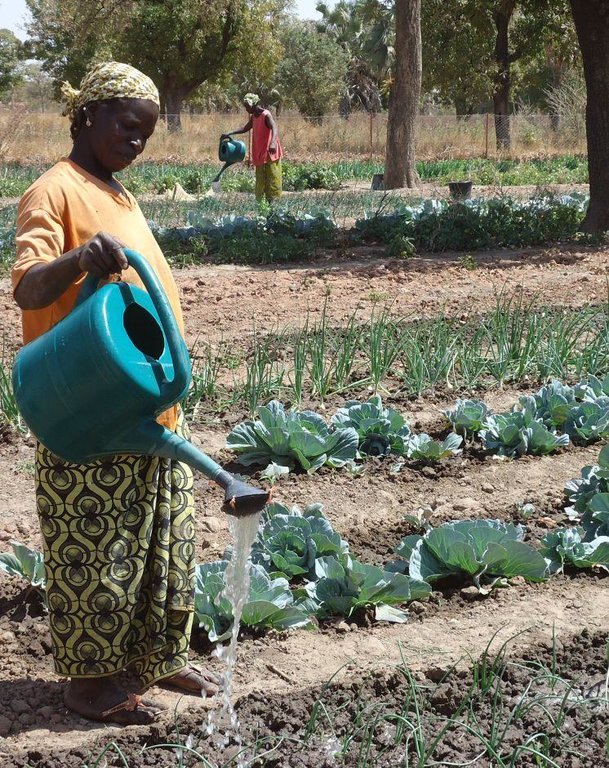Diversifying women’s income streams through market gardening [ប្រទេសម៉ាលី]
- ការបង្កើត៖
- បច្ចុប្បន្នភាព
- អ្នកចងក្រង៖ Dieter Nill
- អ្នកកែសម្រួល៖ –
- អ្នកត្រួតពិនិត្យ Laura Ebneter
Diversification des revenus des femmes par des jardins maraichers
approaches_2501 - ប្រទេសម៉ាលី
ពិនិត្យមើលគ្រប់ផ្នែក
ពង្រីកមើលទាំងអស់ បង្រួមទាំងអស់1. ព័ត៌មានទូទៅ
1.2 ព័ត៌មានលម្អិតពីបុគ្គលសំខាន់ៗ និងស្ថាប័នដែលចូលរួមក្នុងការវាយតម្លៃ និងចងក្រងឯកសារនៃវិធីសាស្ត្រផ្សព្វផ្សាយ
អ្នកជំនាញឯកទេស SLM:
Diassana Joseph
jd@bornefondenmali.org
BØRNEfonden - Children & Youth Foundation
ប្រទេសម៉ាលី
អ្នកជំនាញឯកទេស SLM:
Coulibaly Sourakata
sc@bornefondenmali.org
BØRNEfonden
ប្រទេសម៉ាលី
ឈ្មោះអង្គភាពមួយ (ច្រើន) ដែលបានចងក្រងឯកសារ/ វាយតម្លៃលើវិធីសាស្ត្រផ្សព្វផ្សាយ (បើទាក់ទង)
Deutsche Gesellschaft für Internationale Zusammenarbeit (GIZ) - ប្រទេសអាល្លឺម៉ង់ឈ្មោះអង្គភាពមួយ (ច្រើន) ដែលបានចងក្រងឯកសារ/ វាយតម្លៃលើវិធីសាស្ត្រផ្សព្វផ្សាយ (បើទាក់ទង)
BØRNEfonden - Children & Youth Foundation - ប្រទេសដាណឺម៉ាក1.3 លក្ខខណ្ឌទាក់ទងទៅនឹងការប្រើប្រាស់ទិន្នន័យដែលបានចងក្រងតាមរយៈវ៉ូខេត
តើពេលណាដែលទិន្នន័យបានចងក្រង (នៅទីវាល)?
01/07/2012
អ្នកចងក្រង និង(បុគ្គលសំខាន់ៗ)យល់ព្រមទទួលយកនូវលក្ខខណ្ឌនានាទាក់ទងទៅនឹងការប្រើប្រាស់ទិន្នន័យដែលបានចងក្រងតាមរយៈ វ៉ូខេត:
បាទ/ចា៎
2. ការពណ៌នាអំពីវិធីសាស្ត្រផ្សព្វផ្សាយ SLM
2.1 ពណ៌នាសង្ខេបខ្លីពីវិធីសាស្ត្រផ្សព្វផ្សាយ
Establishing vegetable plots for women enables them to increase their incomes and improve their health by increasing and diversifying agricultural production and improving the nutritional quality of their food.
2.2 ពណ៌នាលម្អិតពិវិធីសាស្ត្រផ្សព្វផ្សាយ
ពណ៌នាលម្អិតពិវិធីសាស្ត្រផ្សព្វផ្សាយ:
Market gardening also enables women to set up savings funds through their associations, builds their capacity to organise and manage market gardens and improves their cultivation techniques. Market gardens set up by women’s associations are usually sited adjacent to lowland areas or rivers so as to facilitate access to water, which is extracted from wells. The areas of these market gardens range from 0.5 to 1 hectare depending on the size of the association and the opportunities for selling produce locally. Allotment sizes range from 80 to 120 square metres per woman. The number of growers per market garden is no greater than 70 women per hectare and 35 women per half-hectare. Women receive a grant in the form of equipment and agricultural inputs. The wells created for the market gardens are 1.4 metres in diameter, have 60-centimetre-high well heads and 30-centimetre-wide footpaths from which to water crops. Eight wells are installed per hectare across the site.
1)A women’s association puts forward its needs, 2)The BØRNEfonden Development Unit carries out a scoping study, 3) Women are organised into an association, 4) The women contribute their share of the costs (10% of the investment costs), 5) A site with guaranteed access to water (i.e. close to the water table) is enclosed, 6)The market garden’s wells are dug, 7)Financial support is provided during the first growing season to pay for equipment and agricultural inputs, 8)The association undertakes a self-assessment and draws up a training plan, 9)BØRNEfonden’s Development Units provide time-limited advisory support, the duration of which depends on capacity-building needs and ranges from three to five years per village. A four-month period of advisory support is allotted to service providers (technical services and consultancies). In order to achieve the best outcomes, it is important to define rules and requirements upfront. These requirements are met by developing an internal control system and nominating an internal control committee. The beneficiaries draw up the management procedures for their site, setting out how it is accessed and how women farmers are selected through internal regulation. Selected committee members receive training in organising and managing the site. Management tools are put in place for this purpose. A plan for the growing season is drawn up with women growers, which means needs can also be evaluated. BØRNEfonden provides the funding. The production costs of sold crops are evaluated and the required funds are then reimbursed by growers through the payment of subscription fees, using a payment system that they have collectively defined. Subscriptions paid by the women are safely set aside in the savings fund created by the association in order to ensure repayments can be made on the equipment paid for by BØRNEfonden.
The women’s association makes a suitable site available and prepares the soil (clearing, grubbing and ploughing). It also contributes a 10% share of the investment and opens a bank account to provide for the repayment of the investment. BØRNEfonden undertakes site development works (laying out, well digging, fencing), carries out crop planning, buys in equipment and agricultural inputs, installs nurseries, establishes and allocates plots, prepares seedbeds, transplants seedlings, and deploys plant health products and fertilisers. BØRNEfonden supports scheme farmers with the growing, harvesting and sale of produce. Local authorities sign the service contracts established between BØRNEfonden and the private contractors hired when the market garden activities got underway (well digging and site fencing). Government and consultancy technical services are involved in performing studies, delivering training in cultivation techniques and monitoring vegetable growing plots.
2.3 រូបភាពនៃវិធីសាស្ត្រផ្សព្វផ្សាយ
2.5 ប្រទេស/តំបន់/ទីតាំងកន្លែង ដែលវិធីសាស្ត្រផ្សព្វផ្សាយត្រូវបានអនុវត្តន៍
ប្រទេស:
ប្រទេសម៉ាលី
តំបន់/រដ្ឋ/ខេត្ត:
Mali
បញ្ជាក់បន្ថែមពីលក្ខណៈនៃទីតាំង:
Yanfolila, Bougouni and Dioïla in the regions of Koulikoro and Sikasso
2.6 កាលបរិច្ឆេទនៃការចាប់ផ្តើម និងបញ្ចប់នៃវិធីសាស្រ្តផ្សព្វផ្សាយនេះ
សូមបញ្ជាក់ឆ្នាំដែលបានបង្កើតឡើង:
2008
2.8 គោលបំណង/ទិសដៅសំខាន់នៃវិធីសាស្ត្រផ្សព្វផ្សាយ
The Approach focused mainly on SLM with other activities
To increase women's incomes and improve their health by increasing and diversifying agricultural production and improving the nutritional quality of their food. Market gardening also enables women to set up savings funds through their associations, builds their capacity to organise and manage market gardens and improves their cultivation techniques.
The SLM Approach addressed the following problems: lack of work, money and food for women; negative ecological impact due to traditional practices such as deforestation or gold mining;
2.9 លក្ខខណ្ឌអនុញ្ញាត ឬរារាំងការអនុវត្តន៍បច្ចេកទេសដែលស្ថិតនៅក្រោមវិធីសាស្រ្តផ្សព្វផ្សាយ
ភាពអាចរកបាននៃធនធានហិរញ្ញវត្ថុ និងសេវាកម្ម
- រារាំង
lack of money
Treatment through the SLM Approach: BØRNEfonden provides the funding. The production costs of sold crops are evaluated and the required funds are then reimbursed by growers through the payment of subscription fees, using a payment system that they have collectively defined. Subscriptions paid by the women are safely set aside in the savings fund created by the association in order to ensure repayments can be made on the equipment paid for by BØRNEfonden.
បរិបទនៃស្ថាប័ន
- រារាំង
Treatment through the SLM Approach: BØRNEfonden supports scheme farmers with the growing, harvesting and sale of produce.
ចំណេះដឹងស្តីពី SLM និងការទទួលបានការគាំទ្រផ្នែកបច្ចេកទេស
- រារាំង
Treatment through the SLM Approach: BØRNEfonden undertakes site development works (laying out, well digging, fencing), carries out crop planning, buys in equipment and agricultural inputs, installs nurseries, establishes and allocates plots, prepares seedbeds, transplants seedlings, and deploys plant health products and fertilisers.
3. ការចូលរួម និងតួនាទីរបស់ភាគីពាក់ព័ន្ធ
3.1 អ្នកពាក់ព័ន្ធដែលបានចូលរួមក្នុងវិធីសាស្ត្រផ្សព្វផ្សាយ និងតួនាទីរបស់ពួកគេ
- អ្នកប្រើប្រាស់ដីក្នុងតំបន់/សហគមន៍
- អ្នកឯកទេសគ្រប់គ្រងដីប្រកបដោយចីរភាព/ទីប្រឹក្សាបច្ចេកទេសកសិកម្ម
- អង្គការក្រៅរដ្ឋាភិបាល
BØRNEfonden
- រដ្ឋាភិបាលថ្នាក់ជាតិ (អ្នករៀបចំផែនការ អ្នកសម្រេចចិត្ត)
Government and consultancy technical services are involved in performing studies, delivering training in cultivation techniques and monitoring vegetable growing plots.
3.2 ការចូលរួមរបស់អ្នកប្រើប្រាស់ដីក្នុងតំបន់/ សហគមន៍ក្នុងតំបន់ក្នុងដំណាក់កាលផ្សេងគ្នានៃវិធីសាស្រ្តផ្សព្វផ្សាយ
| ការចូលរួមរបស់អ្នកប្រើប្រាស់ដីក្នុងតំបន់/សហគមន៍ក្នុងតំបន់ | សូមបញ្ជាក់នរណាត្រូវបានចូលរួម ព្រមទាំងពណ៌នាសកម្មភាពទាំងនោះ | |
|---|---|---|
| ការចាប់ផ្តើម/ការលើកទឹកចិត្ត | អសកម្ម | |
| ការរៀបចំផែនការ | អន្តរកម្ម | |
| ការអនុវត្តន៍ | អន្តរកម្ម | |
| ការត្រួតពិនិត្យ និងវាយតម្លៃ | អសកម្ម | |
| Research | អសកម្ម |
3.4 ការសម្រេចចិត្តលើការជ្រើសរើសបច្ចេកទេស SLM
សូមបញ្ជាក់តើអ្នកណាជាអ្នកបានសម្រេចចិត្តក្នុងការជ្រើសរើសបច្ចេកទេសដើម្បីយកមកអនុវត្តន៍:
- អ្នកប្រើប្រាស់ដី ដោយមានការគាំទ្រពីអ្នកជំនាញឯកទេស SLM
ចូរពន្យល់:
Decisions on the method of implementing the SLM Technology were made by mainly by land users supported by SLM specialists
4. ជំនួយបច្ចេកទេស ការកសាងសមត្ថភាព និងការគ្រប់គ្រងចំណេះដឹង
4.1 ការកសាងសមត្ថភាព/ បណ្តុះបណ្តាល
តើវគ្គបណ្តុះបណ្តាលបានផ្តល់ឱ្យអ្នកប្រើប្រាស់ដី/អ្នកពាក់ព័ន្ធផ្សេងៗទៀតដែរឬទេ?
បាទ/ចា៎
សូមបញ្ជាក់តើអ្នកណាត្រូវបានបណ្តុះបណ្តាល:
- អ្នកប្រើប្រាស់ដី
ទម្រង់នៃការបណ្តុះបណ្តាល:
- អនុវត្តន៍ជាមួយការងារ
- ពីកសិករទីកសិករ
- ការប្រជុំជាសាធារណៈ
- វគ្គបណ្តុះបណ្តាល
4.2 សេវាផ្តល់ប្រឹក្សាយោបល់
តើអ្នកប្រើប្រាស់ដីបានទទួលនូវសេវាផ្តល់ប្រឹក្សាដែរ ឬទេ?
បាទ/ចា៎
សូមបញ្ជាក់ប្រសិនបើសេវាកម្មប្រឹក្សាយោបល់ត្រូវបានផ្តល់ឱ្យ:
- នៅលើដីរបស់អ្នកប្រើប្រាស់ដី
ពណ៌នា/ពន្យល់:
Advisory service is quite adequate to ensure the continuation of land conservation activities
4.3 ការពង្រឹងសមត្ថភាពស្ថាប័ន (ការអភិរឌ្ឍន៍អង្គភាព)
តើស្ថាប័នទាំងអស់ត្រូវបានបង្កើតឡើង ឬពង្រឹងសមត្ថភាពតាមរយៈវិធីសាស្ត្រផ្សព្វផ្សាយដែរ ឬទេ?
- បាទ/ច៎ា បានខ្លាំង
សូមបញ្ជាក់ថាតើស្ថាប័នត្រូវបានពង្រឹង ឬបង្កើតឡើងនៅត្រឹមកម្រិតណា(ច្រើន)?
- ថ្នាក់មូលដ្ឋាន
សូមបញ្ជាក់ប្រភេទនៃការគាំទ្រ:
- ហិរញ្ញវត្ថុ
- ការកសាងសមត្ថភាព/ បណ្តុះបណ្តាល
- សម្ភារៈ
4.4 ការត្រួតពិនិត្យ និងវាយតម្លៃ
តើការត្រួតពិនិត្យ និងវាយតម្លៃគឺជាផ្នែកមួយនៃវិធីសាស្ត្រដែរឬទេ?
បាទ/ចា៎
មតិយោបល់:
Bio-physical aspects were ad hoc monitored by project staff through observations
Technical aspects were ad hoc monitored by project staff through observations
Socio-cultural aspects were ad hoc monitored by project staff through observations
Economic / production aspects were regular monitored by project staff through measurements
Area treated aspects were regular monitored by project staff through measurements
Land users involved aspects were regular monitored by project staff through measurements
Management of Approach aspects were ad hoc monitored by project staff through observations
There were no changes in the Approach as a result of monitoring and evaluation
There were no changes in the Technology as a result of monitoring and evaluation
4.5 ការស្រាវជ្រាវ
តើការស្រាវជ្រាវ គឺជាផ្នែកមួយនៃវិធីសាស្រ្តដែរឬទេ?
បាទ/ចា៎
បញ្ជាក់ប្រធានបទ:
- សង្គមវិទ្យា
- សេដ្ឋកិច្ច/ទីផ្សារ
- បរិស្ថានវិទ្យា
- បច្ចេកវិទ្យា
5. ថវិកា និងសម្ភារៈឧបត្ថម្ភពីខាងក្រៅ
5.1 ថវិកាប្រចាំឆ្នាំសម្រាប់ផ្សព្វផ្សាយ SLM
ប្រសិនបើចំនួនពិតប្រាកដនៃថវិកាប្រចាំឆ្នាំមិនត្រូវបានដឹងច្បាស់ សូមប្រាប់ពីចន្លោះនៃថវិកានោះ:
- 2,000-10,000
មតិយោបល់ (ឧ. ប្រភពសំខាន់នៃមូលនិធិ/ម្ចាស់ជំនួយចំបង):
Approach costs were met by the following donors: international non-government (BØRNEfonden): 90.0%; local community / land user(s): 10.0%
5.2 ការគាំទ្រផ្នែកហិរញ្ញវត្ថុ / សម្ភារៈដែលបានផ្តល់ទៅឱ្យអ្នកប្រើប្រាស់ដី
តើអ្នកប្រើប្រាស់ដីបានទទួលការគាំទ្រផ្នែកហិរញ្ញវត្ថ/សម្ភារៈសម្រាប់ការអនុវត្តន៍បច្ចេកទេសដែរឬទេ:
បាទ/ចា៎
5.3 សូមបញ្ជាក់ពីធាតុចូលត្រូវបានផ្តល់បដិភាគ (រួមទាំងកម្លាំងពលកម្ម)
- សម្ភារៈ
| សូមបញ្ជាក់ ធាតុចូលណាខ្លះដែលបានផ្តល់បដិភាគ | កម្រិតទំហំប៉ុណ្ណា | សូមបញ្ជាក់ពីការបដិភាគ |
|---|---|---|
| ម៉ាស៊ីន | ផ្តល់ហិរញ្ញវត្ថុទាំងស្រុង | |
| ឧបករណ៍ | ផ្តល់ហិរញ្ញវត្ថុទាំងស្រុង | |
- កសិកម្ម
| សូមបញ្ជាក់ ធាតុចូលណាខ្លះដែលបានផ្តល់បដិភាគ | កម្រិតទំហំប៉ុណ្ណា | សូមបញ្ជាក់ពីការបដិភាគ |
|---|---|---|
| គ្រាប់ពូជ | ផ្តល់ហិរញ្ញវត្ថុទាំងស្រុង | |
| ជី | ផ្តល់ហិរញ្ញវត្ថុទាំងស្រុង | |
ប្រសិនបើកម្លាំងពលកម្មធ្វើដោយអ្នកប្រើប្រាស់ដី តើវាជាធាតុចូលដ៏សំខាន់មួយដែរ ឬទេ:
- ដោយស្ម័គ្រចិត្ត
6. ការវិភាគរកផលប៉ះពាល់ និងសេចក្តីសន្និដ្ឋាន
6.1 ផលប៉ះពាល់នៃវិធីសាស្ត្រផ្សព្វផ្សាយ
តើវិធីសាស្ត្រផ្សព្វផ្សាយជួយអ្នកប្រើប្រាស់ដីដើម្បីអនុវត្តន៍ និងថែទាំបច្ចេកទេស SLM?
- ទេ
- បាទ/ច៎ា បន្តិចបន្តួច
- បាទ/ច៎ា ជាមធ្យម
- បាទ/ច៎ា បានខ្លាំង
This new occupation deters women from taking up traditional practices that involve deforestation or environmental damage (gold mining). In light of these very encouraging levels of income, women producers will be more interested in sustaining and continuing their market gardening activities.
តើវិធីសាស្ត្រផ្សព្វផ្សាយនេះផ្តល់សិទ្ធិអំណាចដល់សង្គមនិងសេដ្ឋកិច្ចដែលក្រុមមិនទទួលបានផលប្រយោជន៍?
- ទេ
- បាទ/ច៎ា បន្តិចបន្តួច
- បាទ/ច៎ា ជាមធ្យម
- បាទ/ច៎ា បានខ្លាំង
focus on women
Did other land users / projects adopt the Approach?
- ទេ
- បាទ/ច៎ា បន្តិចបន្តួច
- បាទ/ច៎ា ជាមធ្យម
- បាទ/ច៎ា បានខ្លាំង
The activity has been operating since 2008 with increasing success. Since 2008, 21 development units have supported the installation and management of 57 market gardens, 14 nutrition gardens (based on strip-farmed food crops and jujubes), and 286 wells across a total area of 32.3 hectares. The total number of women farmers involved stands at 2,752. Schemes were installed in 27 communes across the three circles of Yanfolila, Bougouni and Dioïla in the regions of Koulikoro and Sikasso. 26 villages benefited from the installation of market gardens in 12 rural communes in the Koulikoro Region. 31 villages benefited from the installation of market gardens in 15 communes in the Sikasso Region.
Did the Approach lead to improved livelihoods / human well-being?
- ទេ
- បាទ/ច៎ា បន្តិចបន្តួច
- បាទ/ច៎ា ជាមធ្យម
- បាទ/ច៎ា បានខ្លាំង
Dietary diversification resulting from the communities’ (and particularly children’s) access to vegetables and the introduction of certain crops like potato and French beans. The consumption of vegetables and having the financial means to buy different kinds of foods improve the nutritional quality of diets.
Did the Approach help to alleviate poverty?
- ទេ
- បាទ/ច៎ា បន្តិចបន្តួច
- បាទ/ច៎ា ជាមធ្យម
- បាទ/ច៎ា បានខ្លាំង
Some of these women have already been able to capitalise on their incomes by buying livestock (cows, small ruminants). Ensuring women are well organised across the market garden site, promoting good management and increasing the purchasing power of producers are equally important factors in achieving sustainability.
6.2 ការលើកទឹកចិត្តចម្បងៗរបស់អ្នកប្រើប្រាស់ដីសម្រាប់ការអនុវត្តបច្ចេកទេស SLM
- បង្កើនផលិតកម្ម
- បង្កើនប្រាក់ចំណេញ (សមត្ថភាព) បង្កើនអត្រាចំណេញ
- ការចំណាយ/បដិភាគ
6.3 សកម្មភាពផ្សព្វផ្សាយដែលប្រកបដោយចីរភាព
តើអ្នកប្រើប្រាស់ដីអាចធ្វើឱ្យមានចីរភាពនូវអ្វីដែលត្រូវបានអនុវត្តន៍តាមរយៈវិធីសាស្ត្រផ្សព្វផ្សាយដែរឬទេ(ដោយពុំមានការគាំទ្រពីអ្នកខាងក្រៅ)?
- បាទ/ចា៎
ប្រសិនបាទ/ច៎ា សូមរៀបរាប់ថាធ្វើយ៉ាងម៉េច:
The women are now able to reproduce the same approaches. With BØRNEfonden’s support, they have the funds to buy good quality agricultural inputs, which guarantees good production. The savings held in their bank accounts help with equipment repayments.
6.4 ភាពខ្លាំង/ គុណសម្បត្តិនៃវិធីសាស្ត្រផ្សព្វផ្សាយ
| ភាពខ្លាំង/ គុណសម្បត្តិ/ ឱកាស ទស្សនៈរបស់បុគ្គលសំខាន់ៗ |
|---|
| Environmental impacts: a sharp drop in the overcutting of trees to make charcoal, and a sharp drop in traditional gold mining activities and their negative environmental impacts |
| The consumption of vegetables and having the financial means to buy different kinds of foods improve the nutritional quality of diets. |
| Dietary diversification resulting from the communities’ (and particularly children’s) access to vegetables and the introduction of certain crops like potato and French beans. |
| Women’s takings from their vegetable crops range from 35,000 to 125,000 CFA francs, depending on the production scenario and location. We have recorded sales of between 7.5 and 8 tonnes of potato resulting from 25 crates of seed potato. Sold at a rate of 225 CFA francs per kilogram, this generates a total of between 1,687,500 to 1,800,000 CFA francs. |
|
Strengthening the capacities of women vegetable growers ensures the sustainability of this good practice. Indeed, the women are now able to reproduce the same approaches. With BØRNEfonden’s support, they have the funds to buy good quality agricultural inputs, which guarantees good production. The savings held in their bank accounts help with equipment repayments. |
| Market gardening is now being carried out at times when women would traditionally have been without work and lacking money and food. This new occupation deters women from taking up traditional practices that involve deforestation or environmental damage (gold mining). In light of these very encouraging levels of income, women producers will be more interested in sustaining and continuing their market gardening activities. Some of these women have already been able to capitalise on their incomes by buying livestock (cows, small ruminants). Ensuring women are well organised across the market garden site, promoting good management and increasing the purchasing power of producers are equally important factors in achieving sustainability. |
6.5 ភាពខ្សោយ/ គុណវិបត្តិនៃវិធីសាស្ត្រ និងរកដំណោះស្រាយ
| ភាពខ្សោយ/ គុណវិបត្តិ/ ហានិភ័យក្នុងទស្សនៈរបស់បុគ្គលសំខាន់ៗ | តើបច្ចេកទេសទាំងនោះបានដោះស្រាយបញ្ហាដូចម្តេច? |
|---|---|
| The constraints to report relate to: low-rainfall periods (drying up of wells), pests attacking crops, and problems selling crops (poor sales, low sale prices). |
7. ឯកសារយោង និងវេបសាយ
7.1 វិធីសាស្ត្រ/ ប្រភពនៃព័ត៌មាន
- តាមការចុះទីវាល ការស្រាវជ្រាវនៅទីវាល
- ការសម្ភាសន៍ជាមួយអ្នកប្រើប្រាស់ដី
7.2 ឯកសារយោងដែលបានចេញផ្សាយ
ចំណងជើង អ្នកនិពន្ធ ឆ្នាំ ISBN:
Manual of Good Practices in Small Scale Irrigation in the Sahel. Experiences from Mali. Published by GIZ in 2014.
មានប្រភពមកពីណា? ថ្លៃដើមប៉ុន្មាន?
http://star-www.giz.de/starweb/giz/pub/servlet.starweb
ចំណងជើង អ្នកនិពន្ធ ឆ្នាំ ISBN:
Procedures and technical specifications for market garden schemes, BØRNEfonden – Mali
ការតភ្ជាប់ និងម៉ូឌុល
ពង្រីកមើលទាំងអស់ បង្រួមទាំងអស់ការតភ្ជាប់
គ្មានការតភ្ជាប់
ម៉ូឌុល
គ្មានម៉ូឌុល




